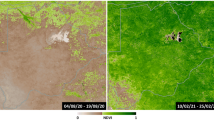Abstract
The unpredictable and erratic rainfall characteristic of semi-arid areas often affects the growing season, hence rangeland productivity. Strategic management is therefore necessary for sustainability of extensive livestock production systems in these areas. A seasonal calendar for fodder and feed availability in a semi-arid landscape was synthesized based on a survey and focus group discussion. Point Centred Quarter method was used to identify the browse species in the area. There was a depletion of the grazing resource in the dry season, but an abundance of highly nutritive browse species. Cereal crop residues were also highlighted to predominate during this season. There were general decreases in crude protein (CP), and dry organic matter digestibility (DOMD) from the wet to the dry season, whilst acid detergent fiber (ADF) and dry matter (DM) increased. However, despite the decrease, CP of all browse species was higher than the minimum levels required for maintenance. A significant difference (P < 0.05) in ADF and DOMD was observed among the species during the dry season, but not in CP and DM (P > 0.05). In the wet season, only ADF significantly differed (P = 0.006) among the species. In order to address challenges due to the temporal variations in both quality and quantity of livestock feeds in semi-arid areas, it is proposed to develop a strategic feeding plan based on a wide range of socio-ecological practices; home based rations, and feed improvement techniques. Other veld management, rehabilitation and restoration methods are recommended.
Access this chapter
Tax calculation will be finalised at checkout
Purchases are for personal use only
Similar content being viewed by others
References
Association of Official Analytical Chemists (AOAC) (1990) Official methods of analysis of the association of official analytical chemists, 15th edn. Washington, DC
Bryant DM, Ducey MJ, Innes JC, Lee TD, Eckert RT, Zarin DJ (2005) Forest community analysis and the point-centered quarter method. Plant Ecol 175:193–203
Burque AR, Abdullah M, Babar ME, Javed K, Nawaz H (2008) Effect of urea feeding on intake and performance of male buffalo calves. J Anim Plant Sci 18(1):1–5
Dzavo T, Zindove TJ, Dhliwayo M, Chimonyo M (2019) Effects of drought on cattle production in sub-tropical environments. Trop Anim Health Prod 51:669. https://doi.org/10.1007/s11250-018-1741-1
IBM Corp. Released (2012) IBM SPSS Statistics for Windows, Version 21.0. IBM Corp, Armonk, NY
Matope A, Zindove TJ, Dhliwayo M, Chimonyo M, (2019) Mitigating the effects of drought on cattle production in communal rangelands of Zimbabwe. Trop Anim Health Prod 1-10. https://doi.org/10.1007/s11250-019-02020-y
Mudzengi CP, Dahwa E, Kapembeza CS (2020) Livestock feeds and feeding in semi-arid areas of Southern Africa. In: Livestock health and farming. IntechOpen. https://doi.org/10.5772/intechopen.90109
Murungweni C, Mabuku O, Manyawu, GJ (2004) Mucuna, Lablab and Paprika calyx as substitutes for commercial protein sources used in dairy and pen-fattening diets by smallholder farmers in Zimbabwe. In: Whitbread AM, Pengelly BC (eds) ACIAR Proceedings No 115. pp 126–135
Murungweni C, Andersson J, van Wijk MT, Gwitira I, Giller K (2012) Zhombwe (Neorautanenia brachypus (Harms) C.A.Sm.)—a recent discovery for mitigating effects of drought on livestock in semi-arid areas of Southern Africa. Ethnobot Res Appl 10:199–212
Ngongoni NT, Mapiye C, Mupeta B, Mwale M, Chimonyo M (2007) Potential of farm—produced crop residues as protein sources for small-medium yielding dairy cows. Afr J Agric Res 2:309–317
Ngongoni NT, Mapiye C, Mwale M, Mupeta B, Chimonyo M (2009) Sunflower based rations for small-medium milk producing dairy cows. Pak J Nutr 8(4):377–383
Oregon State University (OSU) (2021). Forage information systems. https://forages.oregonstate.edu/oregon/topics/forage-production/fertilization-and-soil-fertility
Ouédraogo-Koné S, Kaboré-Zoungrana CY, Ledin I (2008) Intake and digestibility in sheep and chemical composition during different seasons of some West African browse species. Tropical Animal Health Production 40:155–164. https://doi.org/10.1007/s11250-007-9075-4
Tavirimirwa B, Manzungu E, Washaya S, Ncube S, Ncube S, Mudzengi C, Mwembe R (2019) Efforts to improve Zimbabwe communal grazing areas: a review. Afr J Range Forage Sci 36(2):73–83. https://doi.org/10.2989/10220119.2019.1602566
Zengeya FM, Mutanga O, Murwira A (2013) Linking remotely sensed forage quality estimates from WorldView-2 multispectral data with cattle distribution in a savanna landscape. Int J Appl Earth Obs Geoinf 21:513–524
Acknowledgements
We would like to thank Malipati leadership for permission to carry out our study in their area. We also extend profound gratitude to Mr. Mutenga of Grasslands Research Institute for laboratory analysis, as well as Mr Moyana and Mr Zimondi for field assistance.
Author information
Authors and Affiliations
Editor information
Editors and Affiliations
Rights and permissions
Copyright information
© 2022 The Centre for Science and Technology of the Non-aligned and Other Developing Countries (NAM S&T Centre)
About this chapter
Cite this chapter
Mudzengi, C.P., Dahwa, E., Kapembeza, C.S. (2022). A Strategic Livestock Feeding Framework for Semi-Arid Areas. In: Poshiwa, X., Ravindra Chary, G. (eds) Climate Change Adaptations in Dryland Agriculture in Semi-Arid Areas. Springer, Singapore. https://doi.org/10.1007/978-981-16-7861-5_21
Download citation
DOI: https://doi.org/10.1007/978-981-16-7861-5_21
Published:
Publisher Name: Springer, Singapore
Print ISBN: 978-981-16-7860-8
Online ISBN: 978-981-16-7861-5
eBook Packages: Earth and Environmental ScienceEarth and Environmental Science (R0)




